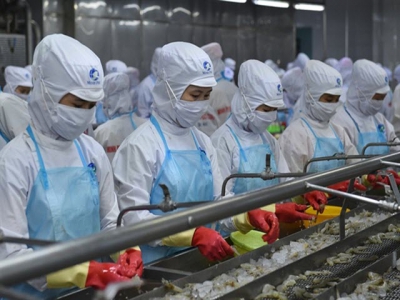Pandemic has little impact on Việt Nams shrimp exports

HÀ NỘI — The domestic shrimp industry has not faced a great impact from the novel coronavirus (COVID-19) pandemic because now this industry is under production and Việt Nam will enter its shrimp harvesting crop in August.
Việt Nam has targeted to gain a total export value of US$4-4.2 billion from shrimp exports this year. — Photo nhandan
According to the Việt Nam Association of Seafood Exporters and Producers (VASEP), many large markets have reduced shrimp imports from China due to the COVID-19 outbreak in this country. That has brought an opportunity for Vietnamese shrimp enterprises to increase their exports to those markets.
With the current difficulties due to the pandemic, especially in China, VASEP said shrimp production, processing and export enterprises have changed their business plans to expand export markets.
Now, the local businesses focus on improving their competitiveness and producing shrimp for export after the pandemic, said VASEP.
Hồ Quốc Lực, Chairman of Management Board and General Director of the Sao Ta Food Joint Stock Company, said in the long term, Việt Nam will take a lot of advantages from the EU-Việt Nam Free Trade Agreement (EVFTA) to increase shrimp exports to the EU.
The EU is Việt Nam's largest shrimp export market, accounting for 20.5 per cent of the total shrimp export value, the association said. According to the EVFTA, the tariffs of most raw shrimp, including fresh, frozen and chilled products, imported from Việt Nam into the EU will be reduced from the basic rate of 12-20 per cent to zero as soon as the agreement comes into effect, expected this year. Meanwhile, import tariffs on processed shrimp will fall to zero after seven years.
The reduction of anti-dumping tariffs in the US market to zero would promote growth in Vietnamese shrimp exports to this market. Now, the US is the second largest export market of Vietnamese shrimp, accounting for 19.4 per cent of total export value, it said.
Bùi Bá Sự, Deputy General Director of the Việt Nam-Australia Seafood Corporation, said farmers should rear shrimp at present to meet higher demand after the pandemic.
At the same time, the farmers should produce clean shrimp and ensure traceability for their product to enjoy preferential tariffs under the EVFTA and increase exports to Europe, he said.
Mai Ngọc Sơn, Director of Quy Nhơn Frozen Joint Stock Company also noted that to take advantage of the EVFTA, local businesses must renew technology and improve product quality.
Besides that, the Import-Export Department under the Ministry of Industry and Trade noted that Việt Nam's shrimp industry will continue to face fierce competition in the world market because more countries have produced shrimp so the price will not see strong growth.
Importing countries have more strict requirements on quality and food safety and those will also affect Việt Nam's seafood exports, including shrimp.
When the EU removes tariffs for Vietnamese exported shrimp to this market, it would set up non-tariff barriers. Of which, the EU has a new regulation on banning the use of Ethoxyquin in all kinds of aquatic feed from March 31, 2020.
Local enterprises also need to promote attraction of foreign investment and join regional supply chains so they could take full advantage of the EVFTA, according to the VASEP.
Việt Nam has targeted to gain a total export value of $10 billion from seafood exports this year, including $4-4.2 billion from shrimp exports.
Related news
 The bad news and good news about seafood exports to China
The bad news and good news about seafood exports to China China was not only Vietnam’s largest Tra fish export market in 2019, but also the fourth largest importer of Vietnamese shrimp.
 Shrimp exporters might cash in on rosier export opportunities in COVID-19 time
Shrimp exporters might cash in on rosier export opportunities in COVID-19 time Despite feeling the pinch of COVID-19, local seafood exporters are seeking to mitigate the impacts and focus on major export markets.
 Shrimp segment above water
Shrimp segment above water Despite the complexities of the COVID-19 pandemic, shrimp exporters and processors still see a bright future ahead thanks to new markets